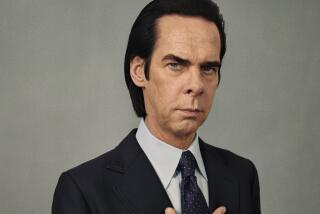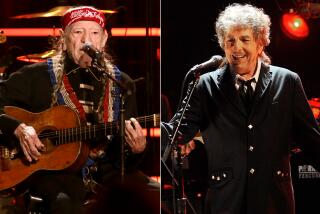POP MUSIC REVIEW : Paul Simon: A Bridge Over International Waters
COSTA MESA — For Paul Simon, mounting a concert tour in the 1990s presents some difficult choices.
Should he emphasize moody material from his elusive latest work, “The Rhythm of the Saints?” Or should he be free with morsels from his widely beloved previous album, “Graceland?” How to weave in earlier solo hits? What to do about nuggets from the early days with Garfunkel?
Beyond all those questions of repertoire, what’s the thematic slant? Simon always has cut a wistful, chastened, ambivalent figure, ever so conscious of life’s sorrows but willing to hope for better things. Should he put on a show that lifts the spirits? Or is it more honest to underscore trouble and pain?
Decisions, decisions. But whatever he plays, Simon can rely on his remarkable 17-member backing group’s ability to make it sound superb.
Each section of the multinational mini-orchestra shone during Simon’s 2-hour, 20-minute show Saturday night at the Pacific Amphitheatre. Abetting it was a near-perfect sound mix that made even Simon’s own light strumming on acoustic guitar clearly audible against that massive band.
Simon drew his fine guitar quartet from Africa; it included Ray Phiri, a South African holdover from the “Graceland” band. In the closing moments of a concert that had been marked by buoyant, rhythmic playing, Phiri hit the height of guitar lyricism, weaving a supremely eloquent solo around Simon’s glistening electric rhythm part during “The Sounds of Silence.” Bass guitarist Armand Sabal-Lecco, from Cameroon, also stood out with motion-filled playing and an exuberant performing style.
Saxophonist Michael Brecker dabbed on exotic sound colors with his exotically colored (lavender) Electronic Wind Instrument, and led the band’s three-man horn section in more conventional brassy blasts. The Waters, a strong vocal backing trio made up of gospel-grounded siblings, may not have been Ladysmith Black Mambazo, but who is?
One doesn’t associate Simon with a muscular sound, but his platoon of four Brazilian percussionists, plus anchoring trap-drummer Steve Gadd, provided some mighty surges. They gave the set’s half-dozen songs from “The Rhythm of the Saints” considerably more dynamic wallop than the album versions. “The Cool, Cool River,” especially, became a complex, shifting journey, now dark and sultry, now bursting from a martial drum attack.
The near-capacity crowd received Simon’s new material well. But it didn’t rise for an ovation until after the band had played “Graceland.” Actually, the song turned out to be rhythmically and melodically static, one of the least involving of the 25 that Simon played. As the title track of his most esteemed album, though, it clearly holds a place of honor with his fans.
The four other “Graceland” songs Simon presented were all highlights, although it was a tad calculating of him to milk the biggest crowd pleaser, “You Can Call Me Al,” by running through it twice in succession. Reprises like that can create stunning moments when they are spontaneous responses to some sudden, connecting spark between listeners and players. Simon’s double-dose of “Al” was pre-programmed.
Still, Simon was at his most playful during “Al”--squared, jukeing about as he smacked a wood block with a drumstick. For the most part, he stuck to business--which meant playing and not speaking. Simon did stop once, during the middle of “Proof,” to announce that “this is definitely different from L.A. (where he had performed the night before, at the Hollywood Bowl), and, personally speaking, preferable.”
Only one of Simon’s decisions turned out badly: his recasting of “Bridge Over Troubled Water” as a quick-paced, lighthearted gospel number with reggae accents--changes that utterly diminished his most moving song. Besides, even though Simon wrote “Bridge Over Troubled Water,” its definitive ingredient was Art Garfunkel’s voice. It would be a gracious gesture for Simon to set “Bridge” aside entirely, unless his old partner is around to take the lead.
As for thematic emphasis, Simon’s show was bound to take on an affirmative glow, given all that rhythmic energy. His set proper ended with a festive, Latin carnival version of “Late in the Evening,” followed by a celebratory gospel tune.
But Simon gave melancholy its due during his encores, which featured his most intimate and most troubled music of the night. “America” and “The Boxer” made for a plaintive first encore. When he returned for the second, it was with an almost bilious version of “Mrs. Robinson.” Simon said it was a new addition to his set, and certainly it was a new interpretation of the song, with the melody deliberately flattened and the vocal phrasings dragging behind the beat for maximum ironic effect.
The original “Mrs. Robinson” had a sardonic edge, too, but it also was a vibrant pop song with a zesty beat and sweet, swelling harmonies. Not this sourpussed rendition. Next came the show-closing “Sounds of Silence,” that cry of terrible isolation in a subway mausoleum.
One suspected, as Simon waved goodby, that he would be back once more to send the crowd off smiling with a sprightly “Cecilia” or “Mother and Child Reunion.” A more obvious child would have done it. Simon let the crowd file out, pondering his downcast ending.
More to Read
The biggest entertainment stories
Get our big stories about Hollywood, film, television, music, arts, culture and more right in your inbox as soon as they publish.
You may occasionally receive promotional content from the Los Angeles Times.











